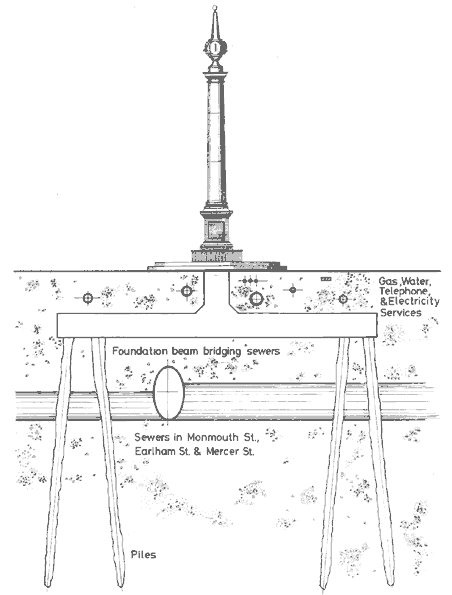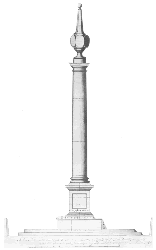|
|
Home Covent Garden & Urban Regeneration The Seven Dials Trust
The Exhibition Completing The Renaissance How you can help the Trust Sponsors and Supporters Contact Information |
The Seven Dials TrustCompleting the Renaissance: The Sundial Pillar & The StreetsThe Trust was set up as a Charity to continue and complete the Renaissance, with the Sundial Pillar's reconstruction as its first task, and promoting environmental improvements. The Sundial Pillar was the first project of its kind in London since the construction of Nelson's Column in 1840. Our Environmental Study, associated literature and initial street improvements are regarded as national exemplars. We are therefore seeking your support for a project which is setting national standards for our built environment. Seven Dials and the Missing Sundial Pillar
Seven Dials was originally laid out by Thomas Neale, MP in the early 1690's. Neale commissioned England's leading stonemason, Edward Pierce, to design and construct the Sundial Pillar in 1693/4 as the centrepiece of his development in Seven Dials. The Pillar was topped by six sundial faces, the seventh 'style' being the column itself. It was regarded as one of London's 'great public ornaments', and the layout and identity of the area revolves around it. Every book on London, including the official Survey of London, refers to the 'story' that the Pillar was pulled down by the mob in 1773, in a search for buried gold. However, the Charity's research has discovered that the Pillar was deliberately pulled down by order of the Paving Commissioners in 1773 in an attempt to rid the area of undesirables who congregated around it. The remains of the demolished column were later purchased by the architect James Paine and were taken to his home at Sayes Court, Addlestone, but were not re-erected there. In 1820, the Duchess Frederica Ulrica, widow of the Duke of York, died at Oatlands in Weybridge, Surrey. The remains of the Pillar, which were still lying on the ground, were purchased via public subscription and re-erected on The Green at Weybridge as a memorial to the Duchess of York. The Dials were replaced with a Coronet. Various attempts were made this century to have the Pillar returned to its original site in Seven Dials, but the Weybridge refused to return it. Our first task was the restoration of the Sundial Pillar - the centrepiece of this unique area - and the 'object' which gave the area its name. Fortunately, Edward Pierce's original working drawing was held in the British Museum, which enabled architect A.D. 'Red' Mason to faithfully reproduce 'this great public ornament', though as you will see below neither the drawing, not the marked dimensions, nor the remains at Weybridge quite tallied. Designing and Building the Sundial PillarThe Pillar was carved and erected in 1988/89 with the bulk of the work carried out by trainee masons at Vauxhall College and Ashby & Horner Stonemasonry Ltd, one of the largest youth training projects for many years in England. One of the greatest problems at the start was how to design the foundations so as to satisfy all the authorities whose services ran beneath the Dials. For example, how could the main sewer be repaired without the Pillar falling down? The ingenious solution can seen in the drawing below. 
Once Red Mason, our architect, had solved the conundrum of designing the new Pillar [see section xxxxx], full size templates were made for each section for the trainees to work from - in effect a 40' high paper pillar!. Apart from the 3 shaft stones of the column, the rest of the Pillar was made largely by hand, as in 1693/4, using traditional wooden mallets to drive fine sharp steel tools. Machines were only used on the larger stones to cut the blocks for the outline shapes. The Pillar is made from 'Whitebed', one of the finest natural beds of Portland Stone. This was chosen because of its weathering qualities and for the ease of working some of the finer details. The trainee masons raised and lowered all the stones by hand, using similar methods to those used in the Seventeenth Century. Each section of the column sits on reinforcing pins joining it to the sections below. The whole erecting process took two and a half months. Caroline Webb designed, carved and gilded the Dialfaces in her studio in Wiltshire. Each Dialstone face enables different hours of the day to be read, so it was essential that each face was carved exactly to the astronomers calculations and that the Dialstone, weighing 1 tonne, was placed accurately to achieve this. Three days were spent with the astronomer on site raising and lowering the Dialstone, with the result that each of the 6 faces is now accurate within ten seconds. Planning and FundraisingThe process of researching, planning and constructing the Sundial Pillar was far more complex and time-consuming than any of the Committee had foreseen at the outset. Planning consent for 'the erection of a column at the centre of Seven Dials' was granted in Spring 1985, and so the project was able to be publicly launched on July 29th 1985. The launch party was attended by over 400 guests and, within six months, £50,000 had been raised to enable consultants to proceed with the final research needed to build the foundations and pillar. In September 1987, a 'topping-in' ceremony was held to celebrate completion of the foundations and a time capsule was buried by local celebrities. The event attracted considerable media attention and more donations followed, thus enabling the working drawings of the pillar and the sundials to be completed. Various fundraising activities and events were held, including stationary running on a barrel, advertising hoardings around the Monument and selling Limited Edition Goods. During the year 2000, we are launching a further appeal to complete the Renaissance: lighting the Pillar, a major city greening scheme, and implementation of the rest of the model street improvements. Details of our various forms of sponsorship are listed in the fundraising section of this website entitled 'How you can help the Charity'. A full list of sponsors and donors are detailed at the end of this website and without their generosity the Sundial Pillar would never have been carved and erected, nor the model street improvements achieved so far. Unveiling of the Sundial Pillar29th June 1989Between its erection and Unveiling, two 40 foot Carlsberg Lager Cans hid the Monument - this inventive form of fundraising raised £10,000, and hid the Pillar until the event. The Unveiling was performed by Her Majesty Queen Beatrix of the Netherlands, accompanied by her husband Prince Claus, to mark the UK finale of the year long William & Mary Tercentenary celebrations. Seven Dials was built during the reign of William & Mary, and Thomas Neale held important positions at Court. He was almost amongst the group who travelled to meet William on his arrival in England. 8,000 Unveiling Balloons in the Dutch National Colours were released - all had tags attached and the furthest reached the Grand Duchy of Luxembourg. Following the ceremony, Queen Beatrix and Prince Claus watched children from St Clement Danes School give an immaculate performance of a short play about 1688/9 (which they wrote) on a giant street map they had painted. The day's events also included a Royal Walkabout and a reception for local residents, businesses and supporters. Later that evening a Foundation Dinner, with a 17th century menu, took place attended by the supporters of the Charity. The Charity is arranging in 2000 for Queen Elizabeth II and Queen Beatrix to receive a leather bound copy of the Environmental Study to commemorate the unveiling of the Sundial Pillar. The binding was carried out by students from the London College of Printing as part of their bookbinding course.
Completing The Renaissance | How you can help the Trust | Sponsors and Supporters | Contact Information |
|
 |

